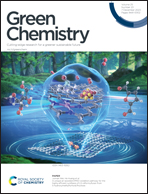Unlocking the graphitization potential of lignin: insights into its transformation through hot pressing and carbonization†
Abstract
The non-graphitizable behavior of lignin has been well recognized as one of the most common issues hindering its valorization. In this study, we demonstrated the great potential of lignin for graphitization using a simple yet effective method of pretreatment using hot pressing. Lignin was found to form a more graphitizable structure with variable carbon–oxygen bonds and fewer carbonyl or ester structures upon hot pressing. The hot-pressed samples (lignin-15t) showed a dramatic increase in sp2 carbon and graphitic microcrystalline with increasing carbonization temperatures compared to the non-hot-pressed samples (lignin-0t). At only 1000 °C, the carbonized lignin-15t exhibited a clearly oriented graphitic structure with the d002 spacing of 0.3454 nm, which was significantly superior to the carbonized lignin-0t or any other lignin-derived carbon carbonized even under harsher conditions. At 1600 °C, the carbonized lignin-15t achieved a graphitization degree of 47.67% with abundant graphitic regions observed in its TEM images. This work can intrigue great interest in lignin graphitization and the applications of lignin-derived carbon materials.



 Please wait while we load your content...
Please wait while we load your content...